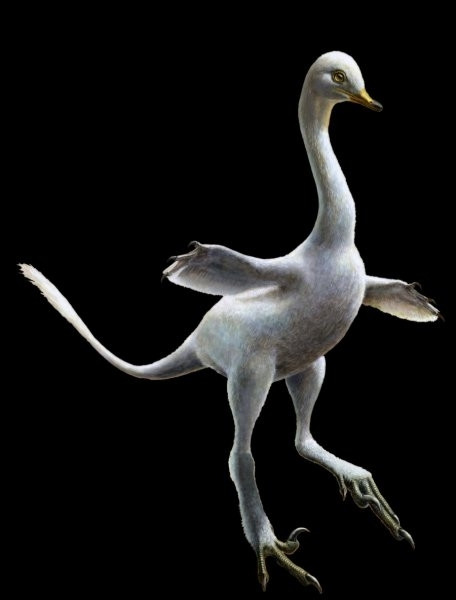Dinosaur with velociraptor claws, crocodile teeth, swan neck and penguin-like swimming skills found
The fossil is of a new dinosaur species named Halszkaraptor escuilliei and is believed to be related to velociraptors.
Archaeologists are surprised and excited about the recent discovery of a new dinosaur fossil which reveals that around 70 million years ago a bizarre-looking predator that could swim underwater and walk on land, roamed the Earth.
The stunningly well-preserved fossil reveals that the new species of dinosaur, which has been named Halszkaraptor escuilliei, had killer claws similar to the ones velociraptors possessed, had hidden rows of sharp crocodile-like teeth, an elongated swan-like neck and flippers that likely allowed it to have penguin-like underwater swimming skills.
An international team of researchers used 3D synchrotron analysis to study the fossil, which revealed that the dinosaur lived in present-day Mongolia during the Cretaceous Period. The swan-necked and flipper-forelimbed dinosaur's versatile features – it has both bird-like and aquatic features – have stumped palaeontologists.
"The first time I examined the specimen, I even questioned whether it was a genuine fossil," Andrea Cau of the Geological Museum Capellini in Bologna said, the ScienceDaily reported.
National Geographic cited Cau as saying: "The fossil was so complete, beautifully preserved, and at the same time so enigmatic and bizarre, with a completely unexpected mix of strange features. It was the most exciting challenge for a paleontologist!"
Fossil smuggled to Europe
The fossil, which was found at Ukhaa Tolgod, had previously been dug up by poachers and smuggled to fossil black markets in Europe, National Geographic reported.
"Illicit fossil trade presents a great challenge to modern palaeontology and accounts for a dramatic loss of Mongolian scientific heritage," Pascal Godefroit of the Royal Belgian Institute of Natural Sciences in Brussels reportedly said. "Illegally exported from Mongolia, Halszka resided in private collections around the world before it was acquired in 2015 and offered to palaeontologists for study and to prepare its return to Mongolia."
Researchers determined the integrity of the fossil using 3D synchrotron multi-resolution X-ray microtomography, which helped them reconstruct the specimen. "This technique is currently the most powerful and sensitive method to image internal details without damaging invaluable fossils.
The ESRF (European Synchrotron Radiation Facility) has become the worldwide leader for high quality X-ray imaging of such precious specimens," said Paul Tafforeau of the ESRF, according to the ScienceDaily. "So far, it's the specimen for which the greatest number of experiments were made on a single fossil."
According to Vincent Beyrand of the ESRF, the dinosaur had "a neurovascular mesh inside its snout that resembles those of modern crocodiles" which indicated that the prehistoric creature was essentially an aquatic predator.
The dinosaur, which is believed to be related to velociraptors, appears to have possessed multiple predatory features, allowing the ancient creature to hunt prey on land and underwater. National Geographic reported that the dinosaur's long swan-like neck likely allowed it to strike unsuspecting prey, while its strong flipper-like limbs likely helped it kick powerfully through water.
"When we add up all the [characteristics] it shows that it was an amphibious animal – it was able to run on land, as we imagine dinosaurs running around, and on top of that it was able to go into water," Vincent Fernandez, a palaeontologist at ESRF, told the Guardian.
The research describing the features of the newly discovered fossil has been published in the journal Nature.
Apart from revealing previously unknown information about dinosaurs, the new findings also provide hope for palaeontologists conducting research in well-known archaeological sites of discovering similar incredible finds.
"Even in very well-known sites, we can still find new animals and show that they have an incredible diversity of forms that we never even expected before. I doubt that we know one percent of one percent that lived in the world," the study's co-author Philip Currie, a paleontologist at the University of Alberta, told National Geographic.























